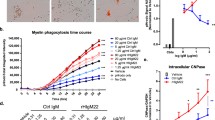Abstract
Myelin is phagocytosed by microglia (MG) and to a somewhat lesser extent by peritoneal macrophages (Mϕ) in a dose- and time-dependent manner. In serum-free medium opsonization of rat myelin significantly enhances binding and ingestion, more by rat macrophages than by microglia. Furthermore the requirement for opsonization is not restricted to anti-myelin antibodies as the difference in the rate of myelin uptake by macrophages is largely eliminated when they are cultured in 10% fetal calf serum. Binding and ingestion of both myelin and opsonized myelin are inhibited to the same dose-dependent extent by zymosan, oxidized LDL, peroxidase-antiperoxidase (PAP), opsonized erythrocytes and the anti-CR3 antibody OX42 implicating lectin, scavenger, Fc and complement receptors in the phagocytosis of myelin. Thus while the differential uptake of myelin and opsonized myelin by macrophages would indicate a central role for the Fc receptor, binding inhibition studies implicate a range of membrane receptors which would obviate the need for antigen-antibody complexing to stimulate phagocytosis. Uptake of both myelin preparations by macrophages or microglia is stimulated by interferon-γ and inhibited by TGF-β, and the process of ingestion results in increased nitric oxide release and decreased superoxide production, the effect being more pronounced when myelin is opsonized.
Similar content being viewed by others
References
Cuzner, M. L., Hayes, G. M., Newcombe, J., and Woodroofe, M. N. 1988. The nature of inflammatory components during demyelination in multiple sclerosis. Journal of Neuroimmunol 20:203–209.
Goldenberg, P. Z., Kwon, E. E., Benjamins, J. A., Whitaker, J. N., Quarles, R. H., and Prineas, J. W. 1989. Opsonization of normal myelin by anti-myelin antibodies and normal serum. J. Neuroimmunol. 23:157–166.
Trotter, J., DeJong, L. D., and Smith, M. E. 1986. Opsonization with antimyelin antibody increases the uptake and intracellular metabolism of myelin in inflammatory macrophages. J. Neurochem. 47:779–789.
Smith, M. E. 1993. Phagocytosis of myelin by microglia in vitro. J. Neurosci. Res. 35:480–487.
Williams, K., Ulvestad, E., Waage, A., Antel, J. P., and Mclaurin, J. 1994. Activation of adult human derived microglia by myelin phagocytosis in vitro. J. Neurosci. Res. 38:433–443.
Norton, W. T., and Cammer, W. 1984. Chemical pathology of disease involving myelin. In: Pages 369–403, Morrell, P. (ed) In “Myelin”. Plenum, New York.
Hayes, G. M., Woodroofe, M. N., and Cuzner, M. L. 1988. Characterization of microglia isolated from adult human and rat-brain. J. Neuroimmunol. 19:177–189.
Ding, A. H., Nathan, C. F., and Stuehr, D. J. 1988. Release of reactive nitrogen intermediates and reactive oxygen intermediates from mouse peritoneal macrophages. Comparison of activating cytokines and evidence for independent production. J. Immunol. 141:2407–2412.
Pick, E., and Mizel, D. 1981. Rapid microassays for the measurement of superoxide and hydrogen peroxide production by macrophages in culture using an automatic enzyme immunoassay reader. J. Immunol. Meth. 46:211–216.
Loughlin, A. J., Woodroofe, M. N., and Cuzner, M. L. 1992. Regulation of Fc receptor and major histocompatibility complex antigen expression on isolated rat microglia by tumor-necrosis-factor, interleukin-1 and lipopolysaccharide—effects on interferon-gamma induced activation. Immunology 75:170–175.
Krieger, M., Acton, S., Ashkenas, J., Pearson, A., Penman, M., and Resnick, D. 1993. Molecular flypaper, host defense, and atherosclerosis. J. Biol. Chem. 268:4569–4572.
Endemann, G., Stanton, L. W., Madden, K. S., Bryant, C. M., White, R. T., and Protter, A. A. 1993. CD 36 is a receptor for oxidized low density lipoprotein. J. Biol. Chem. 268:11811–11816.
Streit, W. J. and Kreutzberg, G. W. 1987. Lectin binding by resting and reactive microglia. J. Neurocytol. 16:249–260.
Schreiber, S., Perkins, S. L., Teitelbaum, S. L., Chappel, J., Stahl, P. D., and Blum, J. S. 1993. Regulation of mouse bone marrow macrophage mannose receptor expression and activation by protaglandin E and IFN-γ1. J. Immunol. 151:4973–4981.
Kimberly, R. P., Tappe, N. J., Merriam, L. T., Redecha, P. B., Eddberg, J. C., Schwartzman, S., and Valinsky, J. E. 1989. Carbohydrates on human Fc receptors. J. Immunol. 142:3923–3930.
Sanguedolce, M. V., Capo, C., Bouhamadan, M., Bongrand, P., Huang, C. K., and Mege, J. L. 1992. Zymosan induced tyrosine phosphorylations in human monocytes. J. Immunol. 151:405–414.
Aramaki, Y., Murai, M., and Tsuchiya, S. 1993. Contribution of N-acetyl-β-D-galactosamine-specific lectin to Fc receptor-mediated phagocytosis by mouse peritoneal macrophages. Immunology 79:403–407.
Ulvestad, E., Williams, K., Vedeler, C., Antel, J., Nyland, H., Mork, S., and Matre, R. 1994. Reactive microglia in multiple sclerosis lesions have an increased expression of receptors for the Fc part of IgG. J. Neurol. Sci. 121:125–131.
Loughlin, A. J., Woodroofe, M. N., and Cuzner, M. L. 1993. Modulation of interferon-gamma-induced major histocompatibility complex class-11 and Fc-receptor expression on isolated microglia by transforming growth-factor-beta-1, interleukin-4, noradrenaline and glucocorticoids. Immunology 79:125–130.
Corradi, S. B., Buchmuller-Rouller, Y., and Mauel, J. 1991. Phagocytosis enhances murine macrophage activation by interferon-and tumor necrosis factor-α. Eur. J. Immunol. 21:2553–2558.
Fabian, R. H., and Rea, H. C. 1993. Neuronal toxicity by macrophages in mixed braincell culture is augmented by antineuronal IgG and dependent upon nitric oxide synthesis. J. Neuroimmunol. 44:95–102.
Loegering, D. J., and Schwacha, M. G. 1991. Macrophage hydrogen peroxide production and phagocytic function are decreased following phagocytosis mediated by Fc receptors but not complement receptors. Biochem Biophys Res Commun 180:26–272.
Author information
Authors and Affiliations
Additional information
Special issue dedicated to Dr. Marion E. Smith.
Rights and permissions
About this article
Cite this article
Mosley, K., Cuzner, M.L. Receptor-mediated phagocytosis of myelin by macrophages and microglia: Effect of opsonization and receptor blocking agents. Neurochem Res 21, 481–487 (1996). https://doi.org/10.1007/BF02527713
Accepted:
Issue Date:
DOI: https://doi.org/10.1007/BF02527713




